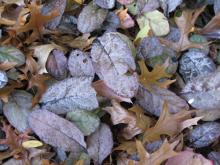Cause Both Golovinomyces biocellatus and Neoerysiphe galeopsidis have been reported on Ajuga from North America. Powdery mildew has not been reported formally for the Pacific Northwest, but it is a common problem. This fungus is favored by conditions that produce high humidity but dry leaves. It is a highly specialized pathogen that forms a close association with the host. Conditions that favor the host also favor the pathogen. Much of the fungus remains outside infected plant parts where it grows on the surface but sinks root-like structures called haustoria into plant cells to obtain nutrients. The white growth seen is composed of both mycelium and fungal spores.
Symptoms Grayish-white, powdery spots develop on leaves. May cover entire surface of the leaf by the end of the growing season.
Cultural control
- Space plants for good air circulation.
- Grow resistant cultivars.
Chemical control Fungicides will do best when used before symptoms develop. Few materials have good eradicant activity. Use at 7- to 14-day intervals; using shorter intervals when environmental conditions favor disease development. Alternate or tank-mix products from different groups that have different modes of action.
- Bicarbonate-based products (85% potassium bicarbonate) might be used to supplement a normal program when powdery mildew is first observed. Do not mix with acidifying agents. Thorough and frequent coverage is essential. O
- MilStop at 2.5 to 5 lb/A in the field or 1.25 to 5 lb/100 gal water in the greenhouse. Oregon and Washington only. 1-hr reentry.
- Heritage at 1 to 4 oz/100 gal water plus a non-silicone-based wetter sticker. Group 11 fungicide. 4-hr reentry.
- Insignia SC at 3 to 6 fl oz/100 gal water. Do not use with organosilicate-based adjuvants. Use preventively only. Group 11 fungicide. 12-hr reentry.
- Seido at 4 to 5 fl oz/100 gal water plus an adjuvant. Group 50 fungicide. 4-hr reentry.
- Terraguard SC at 4 to 8 fl oz/100 gal water. Group 3 fungicide. 12-hr reentry.
Reference Braun, U. and Cook, R.T.A. 2012. Taxonomic Manual of the Erysiphales (Powdery Mildews). CBS-KNAW Fungal Biodiversity Center, The Netherlands.


